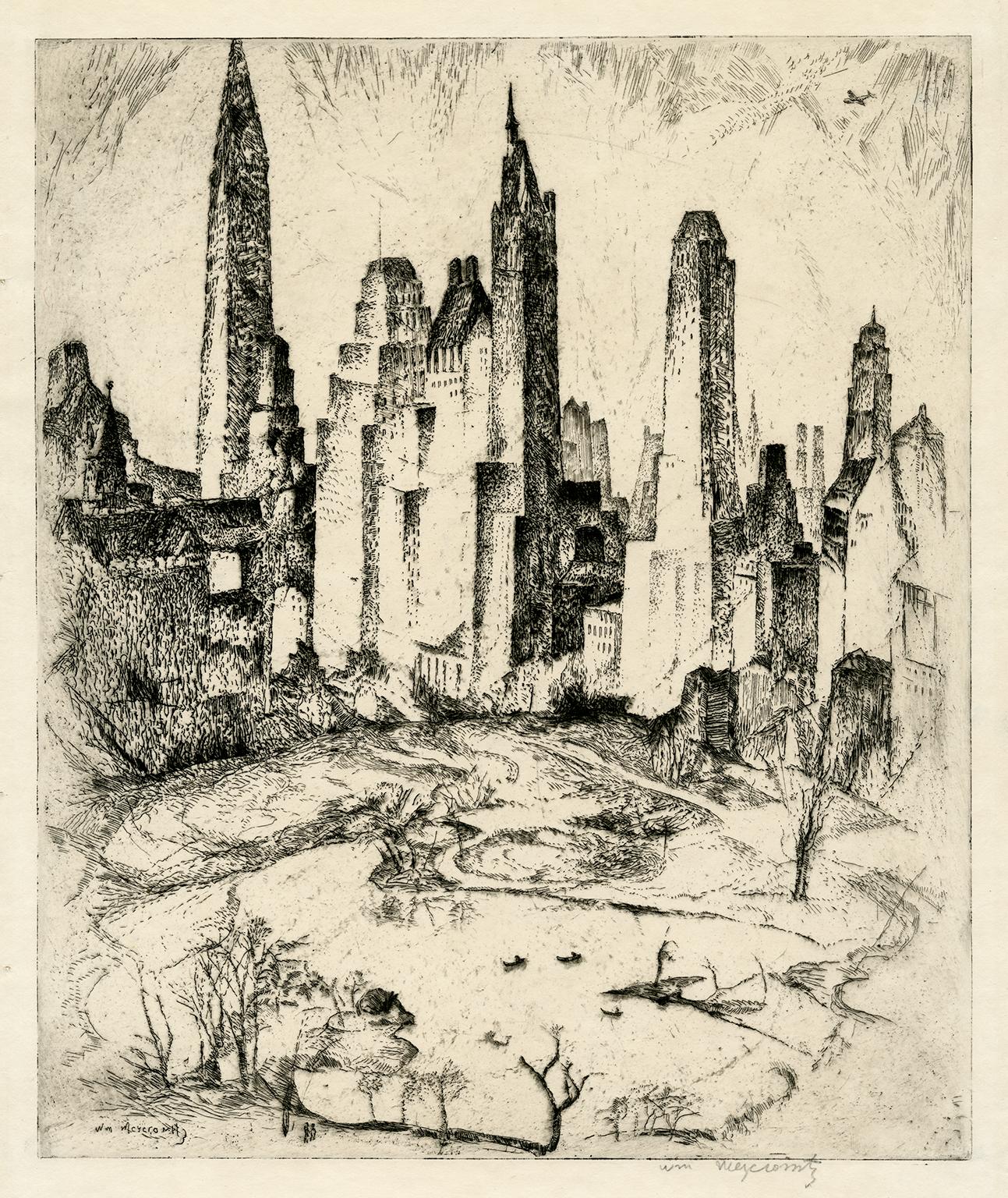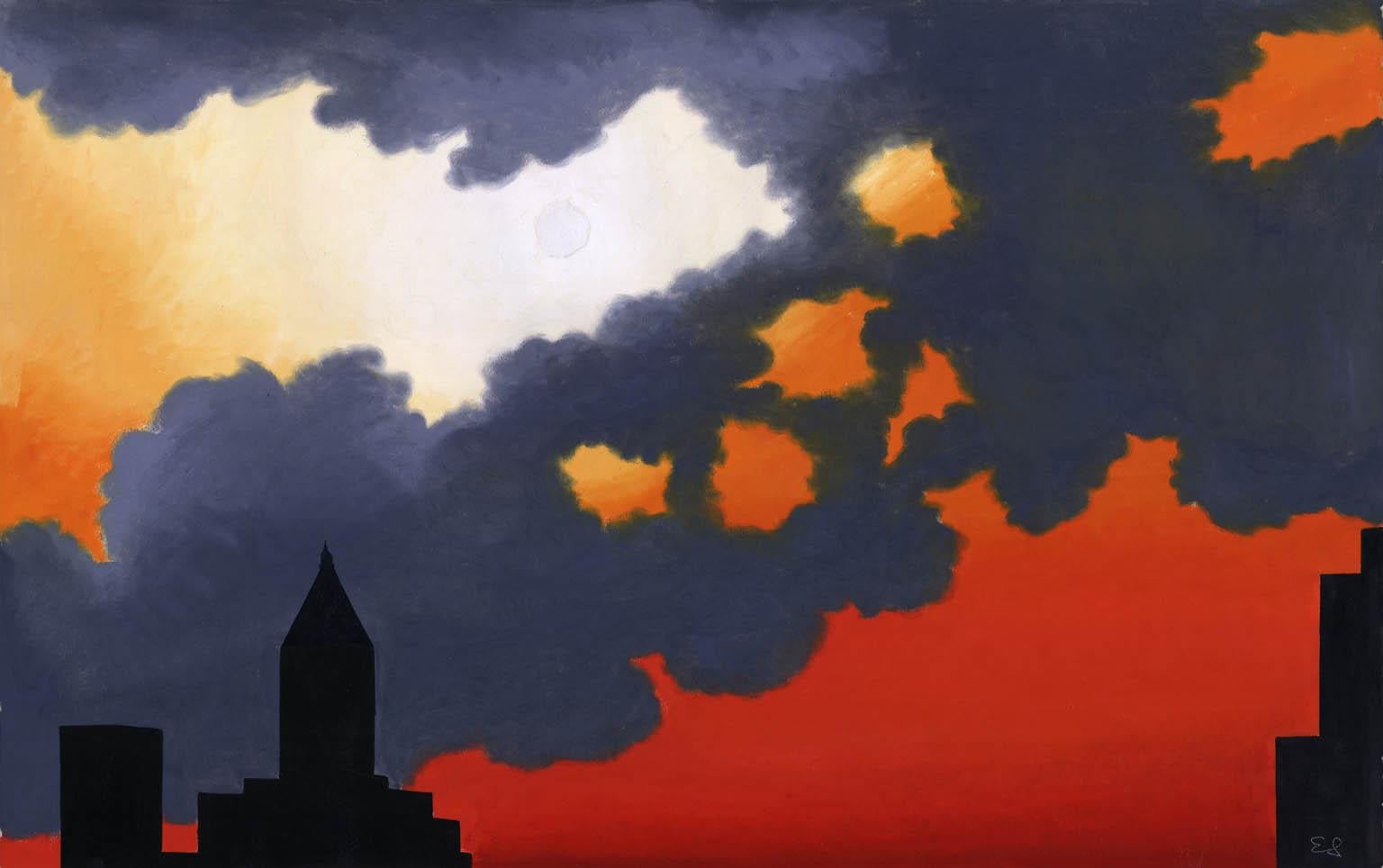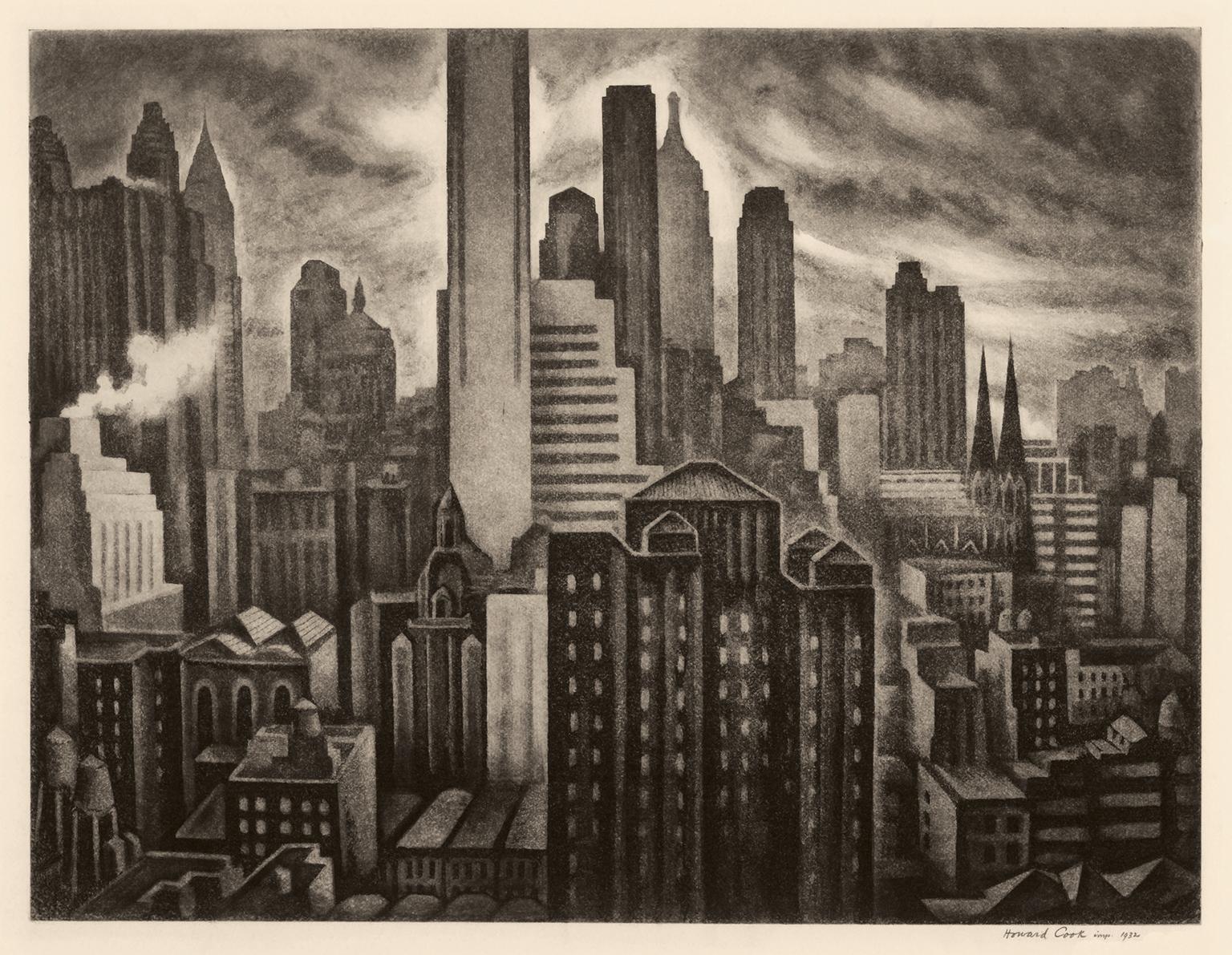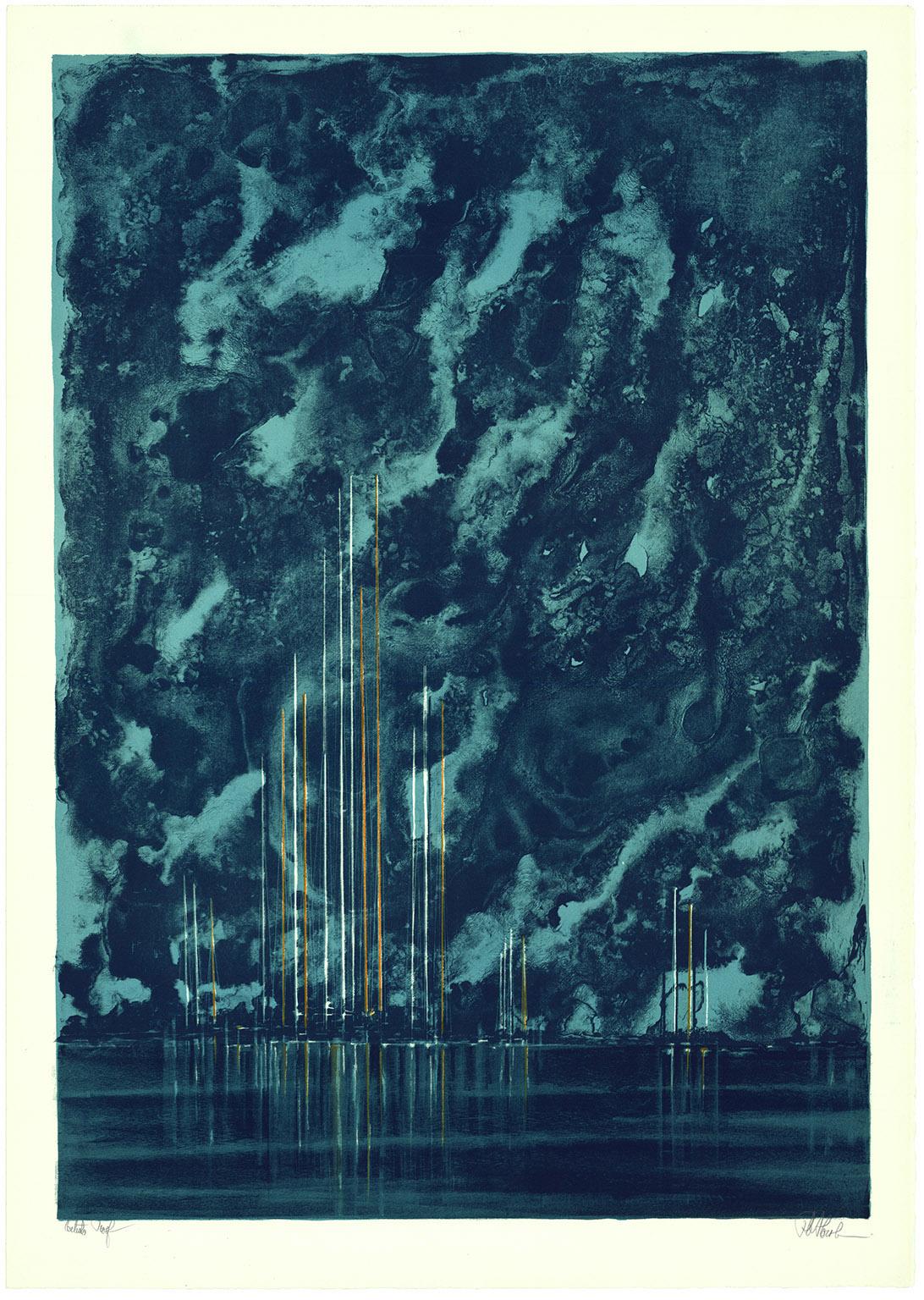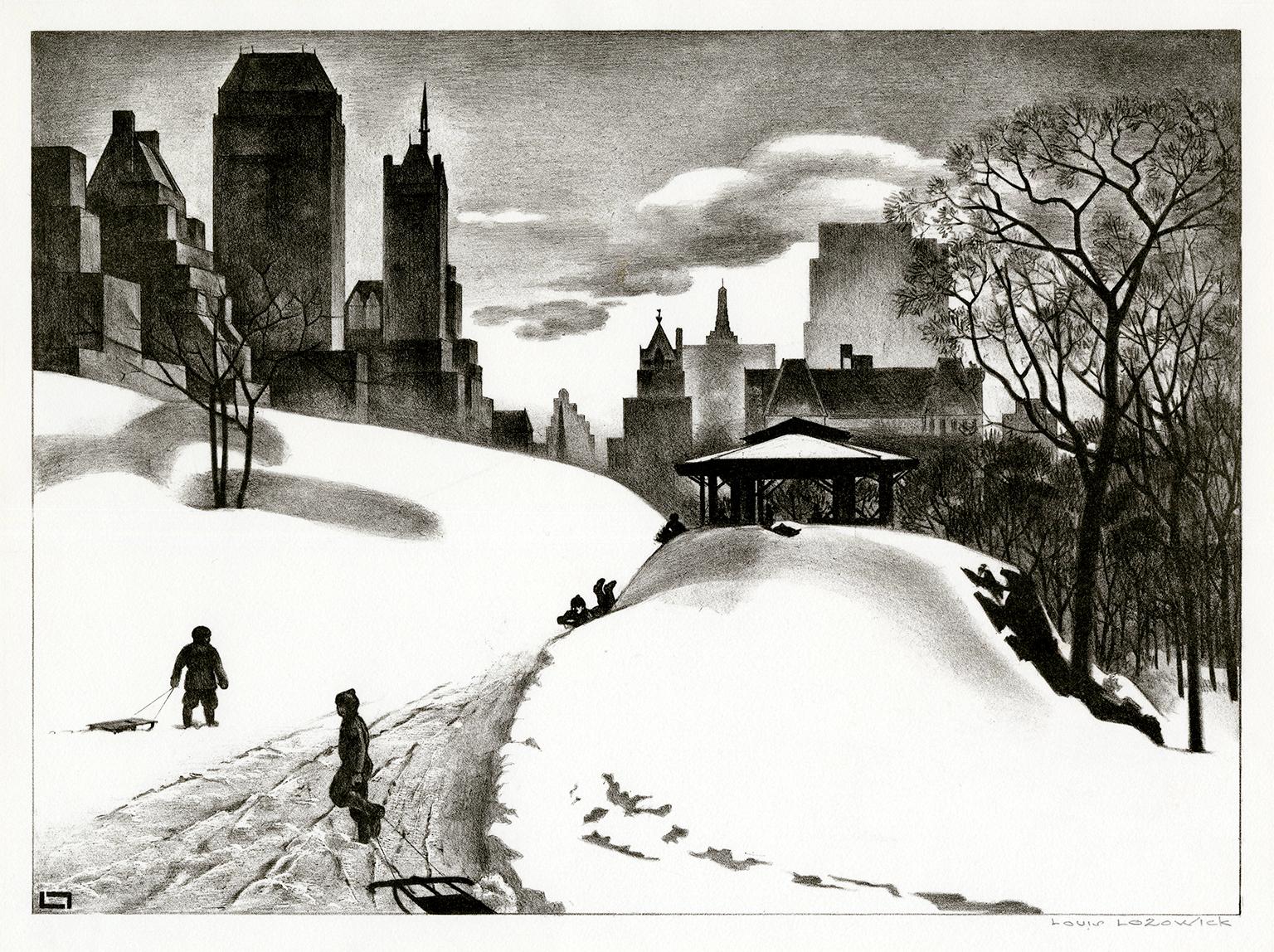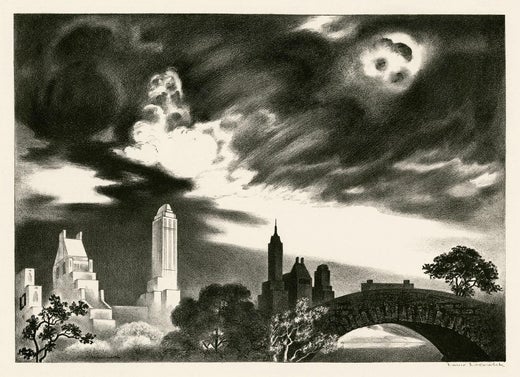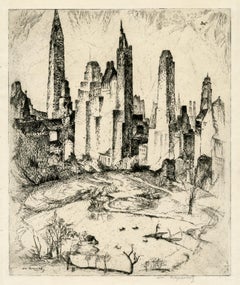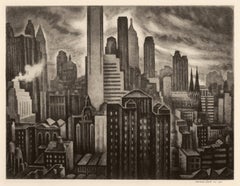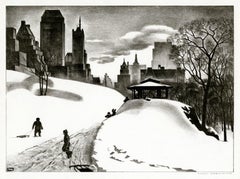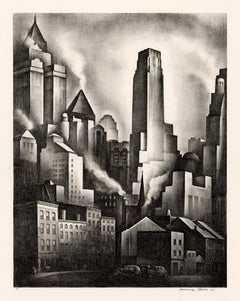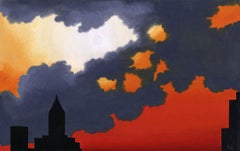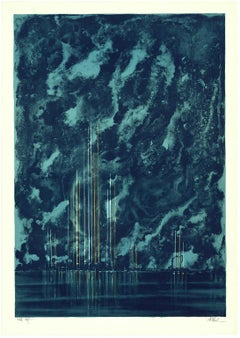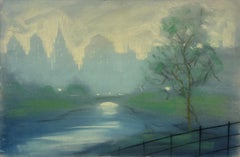Items Similar to Angry Skies (Andante Cantabile) — Central Park, New York City
Want more images or videos?
Request additional images or videos from the seller
1 of 3
Louis LozowickAngry Skies (Andante Cantabile) — Central Park, New York City1935
1935
$1,900
£1,435.03
€1,658.46
CA$2,665.04
A$2,963.78
CHF 1,551.40
MX$36,154.55
NOK 19,493.95
SEK 18,336.58
DKK 12,379.36
About the Item
Louis Lozowick, 'Angry Skies (Andante Cantabile)', lithograph, 1935; edition 10, AAA 250; Flint 123. Signed in pencil. Signed in the stone, lower left. A fine, richly-inked impression, on cream, wove paper, with margins (7/8 to 1 3/16 inches), in excellent condition. Image size 9 5/8 x 13 1/2 inches; sheet size 11 7/8 x 16 1/8 inches. Matted to museum standards, unframed.
An impression from the second edition printed for Associated American Artists in 1948 by master lithographer George C. Miller.
Impressions of this work are in the following museum collections: Metropolitan Museum of Art, Portland Art Museum, Smithsonian American Art Museum, Whitney Museum of American Art.
ABOUT THE ARTIST
“A beautifully articulated synthesis of strong personal visions and an extraordinary command of black-and-white lithography remained constant. His prints have withstood the inevitable fluctuations of fashion and taste, and today are deservedly appreciated by both connoisseurs and a new generation as among the finest created in twentieth-century America.”
—Janet Flint, The Prints of Louis Lozowick: A Catalogue Raisonné, Hudson Hills Press, NY, 1982.
Born in Russia in 1892, Lozowick came to this country at the age of 14 to join his brother in New York City. By 1919 he had attended art school, finished college, served in the army, and traveled throughout the United States visiting major cities which would later become subjects of his work. From 1919 to 1924 Lozowick lived and traveled throughout Europe, staying in Paris, Berlin, and Moscow. While in Berlin he became friends with Laszlo Moholy-Nagy, El Lissitsky, and the avant-garde Russian artists affiliated with the November-gruppe. On his return to New York in 1924 he joined the executive board of the New Masses and exhibited his machine age drawings, the ‘Machine Ornament’ series in the 1926 exhibition of Katherine Dreier’s Société Anonyme; three years later he made his first prints.
Having assimilated European Constructivist and Cubist theories, and the Bauhaus manifesto promoting the integration of applied and fine art, Lozowick was inspired to present the rapidly growing New York City skyline with its monumental skyscrapers as modern symbols of optimism. Like many other Depression-era artists, he identified closely with the common worker and valued the consummate craft and workmanship dictated by the printmaking process. His versatility and range of interests were exemplified by his stage sets for the 1926 production of Georg Kaiser’s play “Gas,” the first Constructivist production seen in America. A year later, his images and essay were centerpieces in the pivotal 1927 Machine Age Exposition in New York. Lozowick’s first solo exhibition of lithographs depicting primarily soaring urban cityscapes and industrial scenes was mounted by the renowned Weyhe Gallery in 1929.
Assigned to the WPA New York Graphic Arts Division in 1935, he left in 1936 to accept a commission from the prestigious Treasury Relief Art Project for two large oil paintings for the Post Office at 33rd Street in Manhattan. His preliminary lithographic studies for the paintings are among his most compelling images of New York skyscraper and bridge forms.
Returning to the Project in 1938, Lozowick experimented with various printmaking mediums, including wood engraving, drypoint, and screen printing, until the end of his appointment in 1940. During the next three decades, encouraged by Carl Zigrosser of the Weyhe Gallery, he devoted himself primarily to lithography, mounting several solo exhibitions at major New York galleries, and a retrospective at the Whitney Museum of American Art in 1972. Posthumous solo and group exhibitions of Lozowick’s work include the Hirshhorn Museum and Sculpture Garden (2001), de Young Museum (2007), British Museum (2008), National Gallery of Art, Washington D.C. (2015), Whitney Museum of American Art (2015), Brooklyn Museum of Art (2015), and the Palmer Museum of Art (2019).
Louis Lozowick’s graphic works are held in numerous prominent museum collections including the Amon Carter Museum of American Art, Art Institute of Chicago, Baltimore Museum of Art, Brooklyn Museum, Cornell University Library, Museum of Fine Arts (Boston), Museum of Modern Art, New York Public Library, Philadelphia Museum of Art, Smithsonian American Art Museum, Walker Art Center, and the Whitney Museum of American Art.
- Creator:Louis Lozowick (1892 - 1973, American)
- Creation Year:1935
- Dimensions:Height: 9.63 in (24.47 cm)Width: 13.5 in (34.29 cm)
- Medium:
- Movement & Style:
- Period:
- Condition:
- Gallery Location:Myrtle Beach, SC
- Reference Number:Seller: 1036061stDibs: LU53236654502
Louis Lozowick
Louis Lozowick is widely recognized as a key figure in America's Precisionist movement and a leader in mid-20th-century modernist printmaking. His graphic works and paintings have been acquired by numerous museums including the Art Institute of Chicago, Brooklyn Museum, Crystal Bridges Museum of American Art, Fine Arts Museums of San Francisco, Metropolitan Museum of Art, Museum of Modern Art, New York Public Library, Philadelphia Museum of Art, Smithsonian American Art Museum, U. S. Library of Congress and the Whitney Museum of American Art.
About the Seller
5.0
Recognized Seller
These prestigious sellers are industry leaders and represent the highest echelon for item quality and design.
Platinum Seller
Premium sellers with a 4.7+ rating and 24-hour response times
Established in 1995
1stDibs seller since 2016
316 sales on 1stDibs
Typical response time: 1 hour
Associations
International Fine Print Dealers Association
- ShippingRetrieving quote...Shipping from: Myrtle Beach, SC
- Return Policy
Authenticity Guarantee
In the unlikely event there’s an issue with an item’s authenticity, contact us within 1 year for a full refund. DetailsMoney-Back Guarantee
If your item is not as described, is damaged in transit, or does not arrive, contact us within 7 days for a full refund. Details24-Hour Cancellation
You have a 24-hour grace period in which to reconsider your purchase, with no questions asked.Vetted Professional Sellers
Our world-class sellers must adhere to strict standards for service and quality, maintaining the integrity of our listings.Price-Match Guarantee
If you find that a seller listed the same item for a lower price elsewhere, we’ll match it.Trusted Global Delivery
Our best-in-class carrier network provides specialized shipping options worldwide, including custom delivery.More From This Seller
View All'New York, Central Park' — 1930s American Modernism
By William Meyerowitz
Located in Myrtle Beach, SC
'New York, Central Park', etching, edition 40, c. 1930. Signed in pencil. Titled and numbered '14/40' on the bottom sheet edge, in pencil. Signed in the plate, lower left. A superb, ...
Category
1930s American Modern Landscape Prints
Materials
Etching
'Soaring New York' — 1930s American Modernism, New York City
By Howard Norton Cook
Located in Myrtle Beach, SC
Howard Cook, 'Soaring New York', aquatint, soft-ground etching, roulette, 1931-32, edition 25, Duffy 165. Signed, dated, and annotated 'imp' in pencil. A superb, richly-inked, atmosp...
Category
1930s American Modern Figurative Prints
Materials
Etching, Aquatint
Winter Fun — Mid-century Modernism, Central Park, New York City
By Louis Lozowick
Located in Myrtle Beach, SC
Louis Lozowick, 'Winter Fun', lithograph, 1940, edition 20, 250 (1941). Flint 188. Signed in pencil, with the artist’s monogram in the stone, lower left. A...
Category
1940s American Modern Figurative Prints
Materials
Lithograph
'Financial District', New York City — American Modernism
By Howard Norton Cook
Located in Myrtle Beach, SC
Howard Cook, 'Financial District', lithograph, 1931, edition 75, Duffy 155. A fine, richly-inked impression, on cream wove paper, the full sheet with wide margins (2 3/4 to 5 5/8 inches), in excellent condition. Image size 13 5/16 x 10 3/8 inches (338 x 264 mm); sheet size 23 x 16 inches (584 x 406 mm). Matted to museum standards, unframed.
Literature: 'American Master Prints from the Betty and Douglas Duffy Collection', the Trust for Museum Exhibitions, Washington, D.C., 1987.
Collections: Crystal Bridges Museum of American Art, Library of Congress, Metropolitan Museum of Art, Philadelphia Museum of Art, Smithsonian American Art Museum.
ABOUT THE ARTIST
Howard Norton Cook (1901-1980) was one of the best-known of the second generation of artists who moved to Taos. A native of Massachusetts, he studied at the Art Students League in New York City and at the Woodstock Art Colony. Beginning his association with Taos in 1926, he became a resident of the community in the 1930s. During his career, he received two Guggenheim Fellowships and was elected an Academician in the National Academy of Design. He earned a national reputation as a painter, muralist, and printmaker.
Cook’s work in the print mediums received acclaim early in his career with one-person exhibitions at the Denver Art Museum (1927) and the Museum of New Mexico (1928). He received numerous honors and awards over the years, including selection in best-of-the-year exhibitions sponsored by the American Institute of Graphics Arts, the Brooklyn Museum, the Society of American Etchers, and the Philadelphia Print Club. His first Guggenheim Fellowship took him to Taxco, Mexico in 1932 and 1933; his second in the following year enabled him to travel through the American South and Southwest.
Cook painted murals for the Public Works of Art Project in 1933 and the Treasury Departments Art Program in 1935. The latter project, completed in Pittsburgh, received a Gold Medal from the Architectural League of New York. One of his most acclaimed commissions was a mural in the San Antonio Post Office in 1937.
He and Barbara Latham settled in Talpa, south of Taos, in 1938 and remained there for over three decades. Cook volunteered in World War II as an Artist War Correspondent for the US Navy, where he was deployed in the Pacific. In 1943 he was appointed Leader of a War Art Unit...
Category
1930s American Modern Figurative Prints
Materials
Lithograph
'Mural Study: Lower Manhattan' — WPA Era Precisionism
By Louis Lozowick
Located in Myrtle Beach, SC
Louis Lozowick, 'Mural Study: Lower Manhattan', lithograph, edition 10 or fewer, 1936. Flint 135. Signed and dated in pencil. Signed in the stone, lower right.
A fine, richly-inked...
Category
1930s American Modern Landscape Prints
Materials
Lithograph
'Skyline from Jersey Heights' — 1930s Modernism
By Adriaan Lubbers
Located in Myrtle Beach, SC
Adriaan Lubbers, 'Skyline from Jersey Heights', lithograph, 1930, edition 25. Signed, titled, and numbered '4/XXV' in pencil. Dated 'Paris 1930' in pencil. A fine impression, on crea...
Category
1930s Modern Figurative Prints
Materials
Lithograph
You May Also Like
New York Skies.
By Emilio Sanchez
Located in New York, NY
Emilio Sanchez returned to the urban skyline time and again. His passion for the everchanging sky took hold during the 1980's working the ruled lines of the skyscraper in just enough...
Category
1980s Modern Landscape Paintings
Materials
India Ink, Oil, Watercolor
Soaring New York
By Howard Norton Cook
Located in New York, NY
Howard Cook (1901-1980), Soaring New York, aquatint, soft0ground etching, roulette, 1931-2; signed, dated and annotated “imp” in pencil lower right, titled lower margin. Reference: D...
Category
1930s American Realist Landscape Prints
Materials
Etching
Approaching Storm
By Richard Florsheim
Located in New York, NY
Richard Florsheim created this color lithograph entitled “Approaching Storm” in 1967 in an edition of 125 pieces. Published by Associated American Artists and printed by Mourlot Press, Paris, this impression is signed and inscribed “Artist Proof.” It is in good condition with full original color. The printed image size is 28.25 x 19 3/4 inches and the paper size is 31.12 x 22 inches.
RICHARD ABERLE...
Category
1960s American Modern Landscape Prints
Materials
Lithograph
"Central Park" Leon Dolice, New York Central Park Scene, Mid-Century
By Leon Dolice
Located in New York, NY
Leon Dolice
Central Park
Signed lower left
Watercolor on paper
12 x 19 inches
The romantic backdrop of Vienna at the turn of the century had a life-long influence upon the young ma...
Category
1930s American Modern Figurative Drawings and Watercolors
Materials
Paper, Pastel
$2,400 Sale Price
20% Off
Storm Over Central Park
By Klaus Lucka
Located in New York, NY
Archival pigment print
Signed and dated in black ink, l.r.
This artwork is offered by ClampArt, located in New York City.
Category
2010s Contemporary Color Photography
Materials
Archival Pigment
Price Upon Request
1938 George Barford 'In Central Park'
Located in Brooklyn, NY
Paper Size: 9.25 x 9 inches ( 23.495 x 22.86 cm )
Image Size: 7.5 x 6 inches ( 19.05 x 15.24 cm )
Framed: No
Condition: A: Mint
Additional Details: Part of AMERICAN BLOCK PRINT...
Category
1930s American Modern Prints and Multiples
Materials
Woodcut
$240 Sale Price
20% Off
